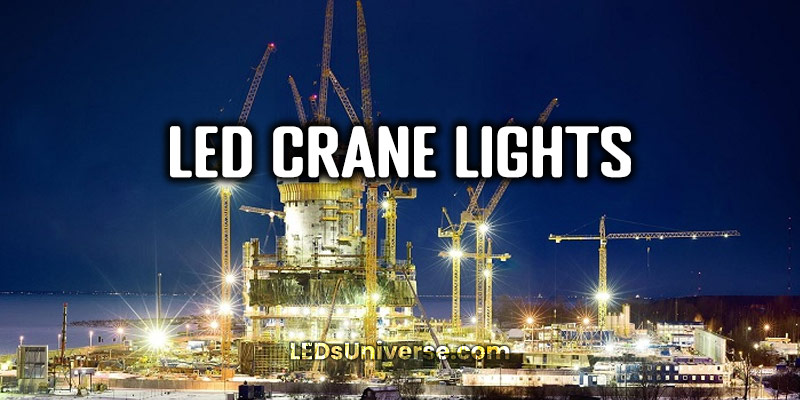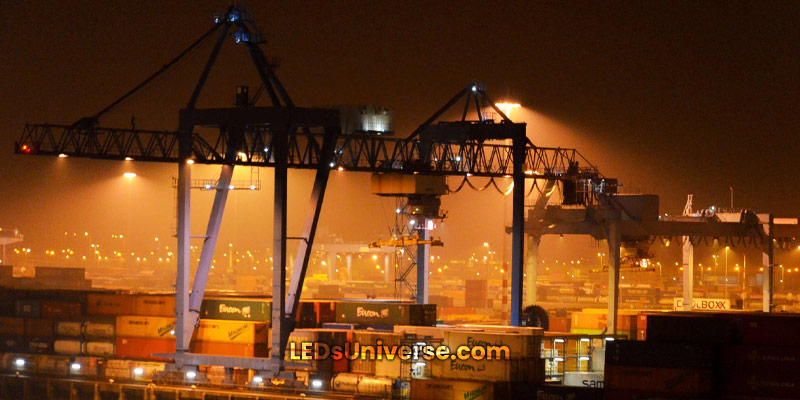
Lighting is an essential aspect of construction sites, as it helps to ensure the safety and efficiency of workers. In particular, lighting is essential for cranes, which are used to lift and move heavy loads at heights. Proper lighting is necessary for crane operators to see their surroundings and the load they are handling, as well as for other workers on the ground to see the movement of the crane.
Adequate lighting can also help to prevent accidents and injuries on the construction site. In addition, lighting can be used to highlight specific areas or tasks, such as loading or unloading materials, to improve efficiency and productivity.
The challenges of lighting cranes
Limited access to power sources
One of the challenges of lighting cranes is limited access to power sources. Cranes are often used in remote locations or at heights, where it may not be practical or possible to access a power outlet or generator. This can make it difficult to power traditional lighting solutions, such as incandescent or halogen lamps.
As a result, we should consider lighting solutions that do not require a direct connection to a power source, or that can be powered by a portable or alternative power source. This might include LED lights that are powered by a battery or solar panel, or that can be connected to a generator or power bank.

Need for durability and ruggedness
Another challenge of lighting cranes is the need for durability and ruggedness. Cranes are often used in harsh and challenging environments, where lighting fixtures may be subject to rough handling, extreme temperatures, moisture, dust, and vibration.
Thus, we can select lighting solutions that are built to withstand these conditions. This might include lights that are sealed and weatherproof, or that are made from durable materials such as aluminum or stainless steel. We also consider the impact resistance and vibration resistance of the lights, as they may be subjected to accidental drops or movement during use.
Need for flexibility and versatility
Cranes are often used for a variety of tasks and in different locations, and the lighting needs may vary depending on the specific application. For example, a crane may require floodlighting for a large area, or spot lighting for a specific task.
We can select lighting solutions that can be easily moved or adjusted to suit different tasks and locations. This might include lights that can be mounted on a tripod, or that have adjustable mounting brackets. We can consider the range and beam angle of the lights, as well as any additional features that may be useful, such as dimming or color changing capabilities.
Types of lighting solutions for cranes
LED floodlights
LED floodlights are a popular lighting solution for cranes and other construction sites. LED (light-emitting diode) technology offers several advantages over traditional lighting technologies, including energy efficiency, long lifespan, and high durability. LED floodlights are designed to produce a wide beam of light, making them suitable for illuminating large areas or surfaces. They are often used for general lighting purposes, such as illuminating the work area or the surrounding environment.
LED floodlights can be mounted on the crane itself or on the ground, depending on the specific application. They may be powered by a direct connection to a power source, or by a battery or solar panel. Some LED floodlights also offer additional features, such as dimming or color changing capabilities.
LED work lights
LED work lights are another type of lighting solution that is commonly used on cranes and construction sites. Like LED floodlights, they are energy efficient and have a long lifespan. However, LED work lights are designed to produce a more focused beam of light, making them suitable for illuminating specific tasks or areas. They may be used for activities such as inspection, maintenance, or repair, where a more concentrated beam of light is needed.
LED work lights can be mounted on the crane or on a separate stand, and may be powered by a direct connection to a power source, a battery, or a solar panel. Some LED work lights also offer additional features, such as adjustable beam angles or color changing capabilities.
Solar-powered lights
Solar-powered lights are a type of lighting solution that is powered by energy from the sun. They are a popular choice for cranes and other construction sites, particularly in remote locations or where access to a power outlet is limited. Solar-powered lights consist of a solar panel, a battery, and a light fixture. The solar panel converts sunlight into electricity, which is stored in the battery. The light fixture is then powered by the battery, providing illumination when needed.
Solar-powered lights may be used as floodlights or work lights, depending on the specific application. They may also offer additional features, such as dimming or color changing capabilities. One potential limitation of solar-powered lights is that they may not produce as much light as traditional powered lights, particularly in low light conditions.
Battery-powered lights
Battery-powered lights are a type of lighting solution that is powered by a rechargeable battery. They are a popular choice for cranes and other construction sites, particularly in remote locations or where access to a power outlet is limited. Battery-powered lights may be used as floodlights or work lights, depending on the specific application. They may be powered by a variety of battery types, including lithium-ion, lead-acid, or nickel-metal hydride.
One potential advantage of battery-powered lights is that they can be used in areas where there is no access to a power source. However, it is required to consider the battery life and the need to periodically recharge or replace the battery. Some battery-powered lights may also offer additional features, such as dimming or color changing capabilities.
Factors to consider when selecting crane lighting
Brightness and beam angle
Brightness is typically measured in lumens, and it refers to the amount of light that is emitted by the fixture. A higher lumen output may be necessary for illuminating large areas or for tasks that require a lot of light.
Beam angle refers to the width of the light beam produced by the fixture. A wider beam angle may be necessary for illuminating a large area, while a narrower beam angle may be more suitable for illuminating a specific task or area. It is required to choose lighting fixtures that are appropriate for the specific needs of the application, taking into consideration the size and layout of the work area and the type of tasks being performed.
Color temperature
Color temperature is another factor to consider when selecting lighting solutions for cranes. Color temperature is a measure of the hue of a light source, and it is typically expressed in degrees Kelvin (K). A higher color temperature corresponds to a cooler, bluish light, while a lower color temperature corresponds to a warmer, yellowish light.
Different color temperatures may be more suitable for different applications, depending on the specific needs of the task. For example, a higher color temperature may be more suitable for tasks that require a lot of visual acuity, such as inspection or repair, while a lower color temperature may be more suitable for tasks that require a more relaxed or comfortable environment, such as office or living spaces. We can choose lighting fixtures that have a color temperature that is appropriate for the specific needs of the application.
Durability and weather resistance
Durability and weather resistance are essential factors to consider when selecting lighting solutions for cranes, as cranes are often used in challenging environments. We can choose lighting fixtures that are built to withstand rough handling, extreme temperatures, moisture, dust, and vibration.
This might include lights that are sealed and weatherproof, or that are made from durable materials such as aluminum or stainless steel. We may consider the impact resistance and vibration resistance of the lights, as they may be subjected to accidental drops or movement during use.
Power source
Cranes are often used in remote locations or at heights, where access to a power outlet may be limited.
We can adopt lighting solutions that do not require a direct connection to a power source, or that can be powered by a portable or alternative power source. This might include LED lights that are powered by a battery or solar panel, or that can be connected to a generator or power bank.
Cost
We may balance the upfront cost of the lighting solution with the long-term benefits and cost savings it may provide.
For example, LED lighting may have a higher upfront cost compared to traditional lighting technologies, but it typically has a longer lifespan and is more energy efficient, which can result in long-term cost savings. We may consider the total cost of ownership of the lighting solution, including the cost of installation, maintenance, and replacement over time. We should also consider any additional costs that may be associated with the power source, such as the cost of fuel for a generator or the cost of replacing batteries.
Conclusion
Lighting is an essential aspect of construction sites, particularly for cranes, which are used to lift and move heavy loads at heights. Proper lighting is necessary for crane operators to see their surroundings and the load they are handling, as well as for other workers on the ground to see the movement of the crane.
Adequate lighting can also help to prevent accidents and injuries on the construction site, and can be used to improve efficiency and productivity. There are various lighting solutions available for cranes, including LED floodlights, LED work lights, solar-powered lights, and battery-powered lights. When selecting a lighting solution for a crane, we need to consider factors such as brightness and beam angle, color temperature, durability and weather resistance, power source, and cost.
At LedsUniverse, we understand the importance of proper lighting on construction sites, particularly for tower cranes. That’s why we offer free lighting design services for tower cranes to help ensure the safety and efficiency of workers. Our team of lighting experts can help you choose the best lighting solution for your specific needs and budget, taking into consideration factors such as brightness and beam angle, color temperature, durability and weather resistance, and power source. Contact us today to take advantage of our free lighting design service and see the difference it can make on your construction site.
